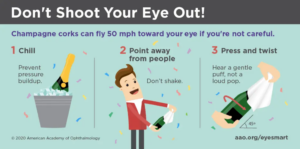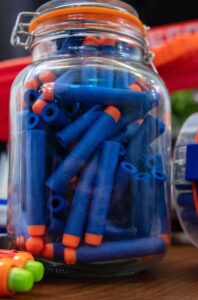In December, even the most cautious of individuals can be affected by increased incidence of blunt force ocular trauma when year-end merry-making leads to careless behavior in adults and children alike. In a month loaded with gift-giving holidays and celebratory occasions, individuals are at risk of eye injuries in the path of high-speed shooting projectiles ranging from newly opened toys to champagne corks released from highly pressurized bottles at holiday parties.
Accordingly, the American Academy of Ophthalmology has declared December as Safe Toys and Celebrations Month. The AAO has outlined a range of common sense eye injury-preventing practices to guide decision-making over the holidays, from selecting non-shooting gifts for children, to practicing significant caution when opening a champagne bottle at parties.
AAO Eye Health Holiday Guide to Children’s Gift-Giving
-
- Avoid purchasing toys with sharp, protruding, or projectile parts that can cause eye injuries, such as BB guns, hard and foam pellets shooters, wall dart sets, slingshots and bow/arrows and other projectile-launching toys. Blunt force ocular trauma due to shooting toys commonly causes corneal abrasions and ocular hyphema (intraocular bleeding). Used recklessly, shooting toys can cause retinal detachment and ruptured eyeballs. If supervising children who are ready to use their new toy shooters, review safety precautions that will prevent eye injuries with them first.
- Toy laser products – In 2013, the Food and Drug Administration issued a new rule — 21 Code of Federal Regulations (CFR) 1040.10 and 1040.11) — to define and require children’s toy “Light Amplification by Stimulated Emission of Radiation” (LASER) products to be within International Electrotechnical Commission (IEC) Class 1 emission limits. With no federal regulations developed for what constitutes children’s toy laser products, this 2013 FDA rule equips parents with a decision-making safety guide in choosing minimal-risk toy laser products where levels of radiation and light do not exceed the limits for Class 1 emission, the IEC’s lowest level in regulated products. (FDA Reference: Laser Toys: How to Keep Kids Safe)
- Purchase recommended protective eyewear as part of the gift. Safety goggles, polycarbonate lenses and impact-resistant shooting glasses have preserved the eyesight of countless children and adults who play sports that carry higher risk for eye injuries.
- Focus on outdoor-inspired gifts, Snow gear, roller skates/blades, a safety-netted trampoline, binoculars, or the classic bicycle all encourage healthy outdoor play and pose significantly lower risk for eye-related injuries. Parents are encouraged to reference AAO’s list of common toys that pose a higher risk of causing traumatic eye injuries.
- Think screen-free gifts for kids to avoid excessive screen time that is associated with eye strain. Reference the AAO’s Computers, Digital Devices and Eye Strain page to learn more.
AAO Eye Health Holiday Guide to Safe Celebrations
Pressure within a champagne bottle ranges from 70–90 pounds per square inch (psi). A cork can fly up to 50 mph as it leaves the bottle, fast enough to shatter glass. If the cork hits an eye, it can cause bleeding, abrasions and even glaucoma. Reference the AAO’s “How To Pop a Champagne Cork Without Harming Your Eye” page for preventive tips in protecting the eyesight of all present at holiday celebratory gatherings.

For a more detailed read on celebrating safely and minimizing risk for blunt force ocular trauma over the holidays and year-round, learn more at the AAO’s here.
@AcademyEyeSmart #dangeroustoys #SafeToysAndCelebrationsMonth
#SafeToysMonth #eyesafety #eyehealth #holidayshopping

